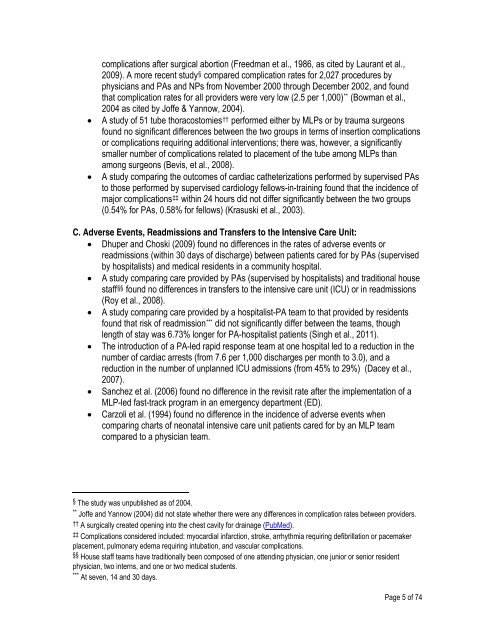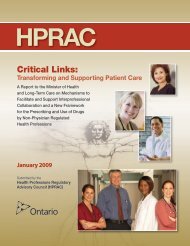Physician Assistants: A Literature Review - Health Professions ...
Physician Assistants: A Literature Review - Health Professions ...
Physician Assistants: A Literature Review - Health Professions ...
- No tags were found...
You also want an ePaper? Increase the reach of your titles
YUMPU automatically turns print PDFs into web optimized ePapers that Google loves.
complications after surgical abortion (Freedman et al., 1986, as cited by Laurant et al.,2009). A more recent study § compared complication rates for 2,027 procedures byphysicians and PAs and NPs from November 2000 through December 2002, and foundthat complication rates for all providers were very low (2.5 per 1,000) ** (Bowman et al.,2004 as cited by Joffe & Yannow, 2004).A study of 51 tube thoracostomies †† performed either by MLPs or by trauma surgeonsfound no significant differences between the two groups in terms of insertion complicationsor complications requiring additional interventions; there was, however, a significantlysmaller number of complications related to placement of the tube among MLPs thanamong surgeons (Bevis, et al., 2008).A study comparing the outcomes of cardiac catheterizations performed by supervised PAsto those performed by supervised cardiology fellows-in-training found that the incidence ofmajor complications ‡‡ within 24 hours did not differ significantly between the two groups(0.54% for PAs, 0.58% for fellows) (Krasuski et al., 2003).C. Adverse Events, Readmissions and Transfers to the Intensive Care Unit: Dhuper and Choski (2009) found no differences in the rates of adverse events orreadmissions (within 30 days of discharge) between patients cared for by PAs (supervisedby hospitalists) and medical residents in a community hospital. A study comparing care provided by PAs (supervised by hospitalists) and traditional housestaff §§ found no differences in transfers to the intensive care unit (ICU) or in readmissions(Roy et al., 2008). A study comparing care provided by a hospitalist-PA team to that provided by residentsfound that risk of readmission *** did not significantly differ between the teams, thoughlength of stay was 6.73% longer for PA-hospitalist patients (Singh et al., 2011). The introduction of a PA-led rapid response team at one hospital led to a reduction in thenumber of cardiac arrests (from 7.6 per 1,000 discharges per month to 3.0), and areduction in the number of unplanned ICU admissions (from 45% to 29%) (Dacey et al.,2007). Sanchez et al. (2006) found no difference in the revisit rate after the implementation of aMLP-led fast-track program in an emergency department (ED). Carzoli et al. (1994) found no difference in the incidence of adverse events whencomparing charts of neonatal intensive care unit patients cared for by an MLP teamcompared to a physician team.§ The study was unpublished as of 2004.** Joffe and Yannow (2004) did not state whether there were any differences in complication rates between providers.†† A surgically created opening into the chest cavity for drainage (PubMed).‡‡ Complications considered included: myocardial infarction, stroke, arrhythmia requiring defibrillation or pacemakerplacement, pulmonary edema requiring intubation, and vascular complications.§§ House staff teams have traditionally been composed of one attending physician, one junior or senior residentphysician, two interns, and one or two medical students.*** At seven, 14 and 30 days.Page 5 of 74
















